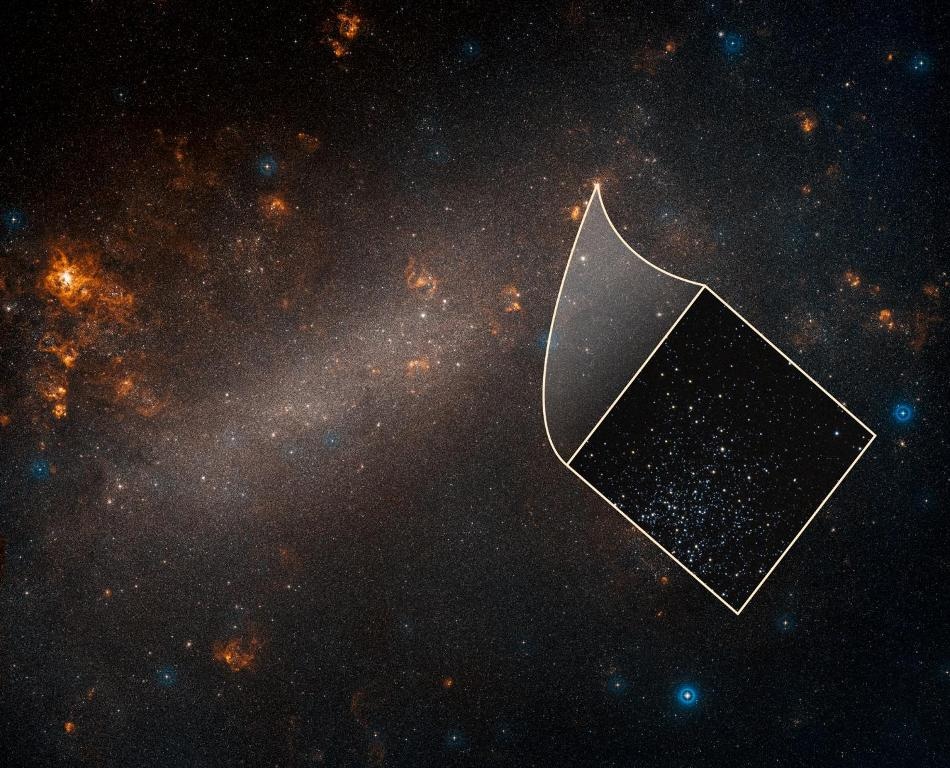Apr 26 2019
Based on new measurements taken by NASA’s Hubble Space Telescope, astronomers report that the universe is expanding nearly 9% faster than expected following the observation of its trajectory shortly after the Big Bang.
 This is a ground-based telescope’s view of the Large Magellanic Cloud, a satellite galaxy of our Milky Way. The inset image, taken by the Hubble Space Telescope, reveals one of many star clusters scattered throughout the dwarf galaxy. (Image credit: NASA, ESA, Adam Riess, and Palomar Digitized Sky Survey)
This is a ground-based telescope’s view of the Large Magellanic Cloud, a satellite galaxy of our Milky Way. The inset image, taken by the Hubble Space Telescope, reveals one of many star clusters scattered throughout the dwarf galaxy. (Image credit: NASA, ESA, Adam Riess, and Palomar Digitized Sky Survey)
The new measurements have been reported in the Astrophysical Journal on April 25th, 2019 and decrease the likelihood that the disparity is incidental from 1 in 3,000 to only 1 in 100,000 and indicate that new physics may be required to gain better insights into the cosmos.
This is not just two experiments disagreeing. We are measuring something fundamentally different. One is a measurement of how fast the universe is expanding today, as we see it. The other is a prediction based on the physics of the early universe and on measurements of how fast it ought to be expanding. If these values don’t agree, there becomes a very strong likelihood that we’re missing something in the cosmological model that connects the two eras.
Adam Riess, Bloomberg Distinguished Professor of Physics and Astronomy, Johns Hopkins University
Riess is also the project’s leader and a Nobel laureate.
As part of this research, Riess and his group—known as the Supernovae, H0, for the Equation of State team (SH0ES)—investigated light from 70 stars in the Large Magellanic Cloud, the neighbor galaxy, using an innovative method that enabled quick images of these stars to be captured. The stars, known as Cepheid variables, brighten and dim at calculable rates that are used to evaluate closeby intergalactic distances.
The typical method used for measuring the stars is extremely time-consuming; only one star can be observed by the Hubble for every 90-minute orbit around Earth. The researchers employed their new technique named DASH (an acronym for drift and shift) to use Hubble as a “point-and-shoot” camera to observe groups of Cepheids, thus enabling the researchers to see a dozen Cepheids in the same time it would usually need to view just one.
Using the new data, Riess and the researchers could strengthen the foundation of the cosmic distance ladder, a method used for determining distances within the universe and for calculating the Hubble constant, a value of the extent to which the cosmos expands over time.
The researchers integrated their Hubble measurements with another set of observations, carried out by the Araucaria Project, a teamwork between astronomers from institutions in Chile, the United States, and Europe. This team performed distance measurements of the Large Magellanic Cloud by viewing the dimming of light when one star passed in front of its partner in eclipsing binary-star systems.
The integrated measurements enabled the SH0ES researchers to refine the Cepheids’ true brightness. Using this highly accurate outcome, the researchers could subsequently “tighten the bolts” of the remaining distance ladder that extends deeper into space by using exploding stars known as supernovae.
With the measurements of the researchers becoming more accurate, their computation of the Hubble constant has been at odds with the anticipated value calculated from observations of the expansion of the early universe by the European Space Agency’s Planck satellite based on conditions observed by Planck 380,000 years after the Big Bang.
This mismatch has been growing and has now reached a point that is really impossible to dismiss as a fluke. This is not what we expected.
Adam Riess, Bloomberg Distinguished Professor of Physics and Astronomy, Johns Hopkins University.
Although Riess cannot come up with a solution to the question why precisely the discrepancy occurs, he and the SH0ES group will continue to tweak the Hubble constant, with the aim of minimizing the uncertainty to 1%. Most recent measurements reduced the uncertainty in the rate of expansion from 10% in 2001, through 5% in 2009, to 1.9% in this study.
Stefano Casertano of the Space Telescope Science Institute, Wenlong Yuan of Johns Hopkins University, Lucas M. Macri of Texas A&M University, and Dan Scolnic of Duke University are the other authors of the study.